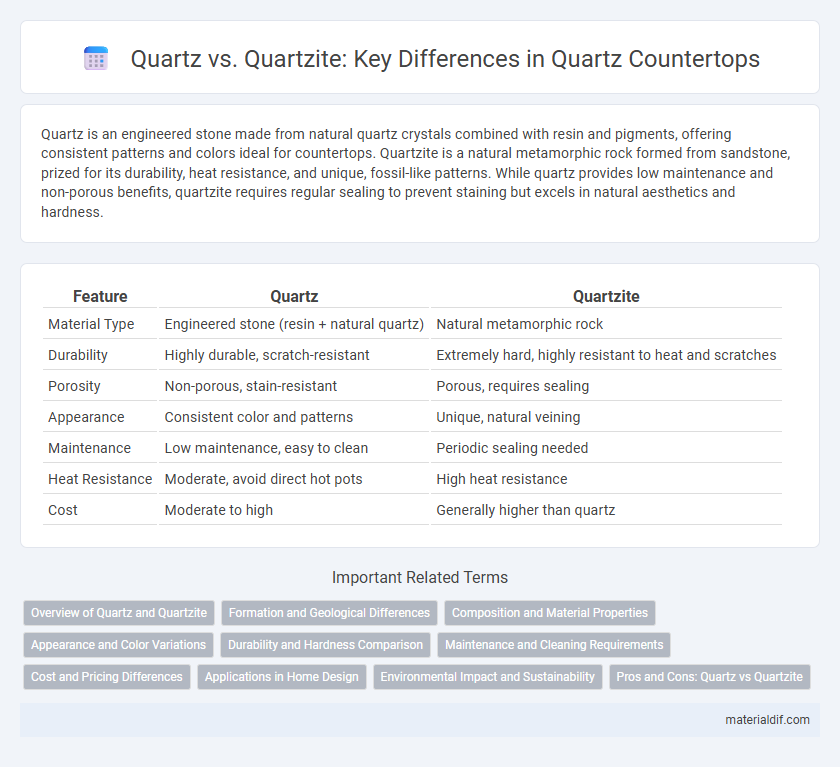Quartz is an engineered stone made from natural quartz crystals combined with resin and pigments, offering consistent patterns and colors ideal for countertops. Quartzite is a natural metamorphic rock formed from sandstone, prized for its durability, heat resistance, and unique, fossil-like patterns. While quartz provides low maintenance and non-porous benefits, quartzite requires regular sealing to prevent staining but excels in natural aesthetics and hardness.
Table of Comparison
| Feature | Quartz | Quartzite |
|---|---|---|
| Material Type | Engineered stone (resin + natural quartz) | Natural metamorphic rock |
| Durability | Highly durable, scratch-resistant | Extremely hard, highly resistant to heat and scratches |
| Porosity | Non-porous, stain-resistant | Porous, requires sealing |
| Appearance | Consistent color and patterns | Unique, natural veining |
| Maintenance | Low maintenance, easy to clean | Periodic sealing needed |
| Heat Resistance | Moderate, avoid direct hot pots | High heat resistance |
| Cost | Moderate to high | Generally higher than quartz |
Overview of Quartz and Quartzite
Quartz is an engineered stone composed of about 90-95% natural quartz crystals combined with resins and pigments, offering consistent color and pattern variations ideal for countertops and surfaces. Quartzite is a natural metamorphic rock formed from sandstone, prized for its durability, natural veining, and resistance to heat and scratches. Both materials provide aesthetic appeal and functionality, but quartz offers low maintenance and non-porous properties, while quartzite requires sealing to prevent staining.
Formation and Geological Differences
Quartz forms as a mineral composed of silicon dioxide, crystallizing from molten magma or precipitating from hydrothermal solutions in igneous, metamorphic, and sedimentary rocks. Quartzite originates from the metamorphism of quartz-rich sandstone subjected to high heat and pressure, causing recrystallization and fusion of quartz grains into a dense, interlocking structure. The primary geological difference lies in quartz being a mineral and quartzite a metamorphic rock, with quartz exhibiting singular crystalline properties while quartzite exhibits a consolidated, hardened rock texture.
Composition and Material Properties
Quartz consists primarily of silicon dioxide (SiO2) crystals formed through a natural crystalline structure, offering high hardness and resistance to chemical weathering. Quartzite originates from sandstone undergoing metamorphism, resulting in a denser, more durable material with interlocking quartz grains that enhances its strength and heat resistance. Quartz is engineered, often combined with resins and pigments, providing greater versatility and customization compared to the naturally occurring, more rigid quartzite.
Appearance and Color Variations
Quartz offers a wide range of uniform colors and patterns due to its engineered composition, featuring consistent veining and subtle sparkle, making it ideal for modern and versatile interior designs. Quartzite, a natural stone, exhibits unique, dramatic veining and color variations including whites, grays, golds, and blues that reflect its geological origins, providing a more organic and textured appearance. These distinct visual characteristics influence kitchen and bathroom aesthetics, with quartz delivering predictable beauty and quartzite offering exclusive, natural elegance.
Durability and Hardness Comparison
Quartzite, a natural metamorphic rock, exhibits superior durability and hardness compared to engineered quartz, with a Mohs hardness rating around 7, making it highly resistant to scratches and heat. Engineered quartz, composed of roughly 90% ground quartz mixed with resins, offers consistent hardness and durability but is generally softer, around Mohs level 6 to 7, which may be susceptible to damage from sharp objects or excessive heat. Selecting quartzite ensures enhanced longevity for high-traffic surfaces, while quartz provides easier maintenance and uniform appearance.
Maintenance and Cleaning Requirements
Quartz surfaces require minimal maintenance due to their non-porous nature, making them resistant to stains and bacteria without the need for sealing. Quartzite, being a natural stone, demands regular sealing to prevent staining and is more sensitive to acidic or abrasive cleaners. Both materials benefit from routine cleaning with mild soap and water, but quartz offers easier day-to-day care and greater durability against common household spills.
Cost and Pricing Differences
Quartz countertops typically range from $50 to $150 per square foot, offering a more budget-friendly option compared to natural quartzite, which costs between $60 and $200 per square foot due to its rarity and quarrying process. Quartz is engineered from crushed quartz and resin, making it less expensive to produce and install, while quartzite is a natural stone requiring specialized cutting and finishing techniques, increasing labor costs. Homeowners seeking high durability at a moderate price often choose quartz, whereas quartzite appeals to those prioritizing natural stone aesthetics despite the higher investment.
Applications in Home Design
Quartz, engineered from natural quartz crystals combined with resins and pigments, excels in kitchen countertops and bathroom vanities due to its non-porous surface and stain resistance. Quartzite, a natural metamorphic rock, is prized for flooring and wall cladding, offering superior hardness and a unique, natural stone appearance. Both materials provide durability and aesthetic appeal, but quartz requires less maintenance, making it ideal for busy home environments.
Environmental Impact and Sustainability
Quartz countertops are engineered products made from about 90% natural quartz combined with resins and pigments, resulting in less mining impact compared to quartzite, which is a natural, quarried metamorphic rock requiring extensive extraction. The manufacturing process of quartz generates emissions from resin curing and transportation, whereas quartzite's environmental footprint largely stems from quarrying activities that disrupt ecosystems and consume significant energy. Choosing quartz can offer better sustainability due to reduced extraction and the potential use of recycled materials in its production, while quartzite remains a more resource-intensive natural stone option.
Pros and Cons: Quartz vs Quartzite
Quartz offers superior non-porous durability, making it highly resistant to stains and scratches, ideal for low-maintenance kitchen surfaces. Quartzite, a natural stone, boasts exceptional heat resistance and unique, natural patterns but requires regular sealing to prevent staining and etching. Quartz provides consistent color and pattern with easier upkeep, while quartzite delivers a more authentic stone aesthetic with higher maintenance demands.
Quartz vs Quartzite Infographic

 materialdif.com
materialdif.com